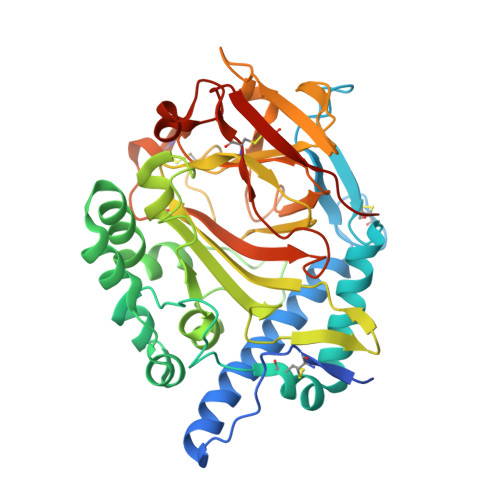Mechanistic Insights into Dimethylsulfoniopropionate Lyase DddY, a New Member of the Cupin Superfamily.
Li, C.Y., Zhang, D., Chen, X.L., Wang, P., Shi, W.L., Li, P.Y., Zhang, X.Y., Qin, Q.L., Todd, J.D., Zhang, Y.Z.(2017) J Mol Biol 429: 3850-3862
- PubMed: 29106934
- DOI: https://doi.org/10.1016/j.jmb.2017.10.022
- Primary Citation of Related Structures:
5XKX, 5XKY, 5Y4K - PubMed Abstract:
The marine osmolyte dimethylsulfoniopropionate (DMSP) is one of Earth's most abundant organosulfur molecules. Bacterial DMSP lyases cleave DMSP, producing acrylate and dimethyl sulfide (DMS), a climate-active gas with roles in global sulfur cycling and atmospheric chemistry. DddY is the only known periplasmic DMSP lyase and is present in β-, γ-, δ- and ε-proteobacteria. Unlike other known DMSP lyases, DddY has not been classified into a protein superfamily, and its structure and catalytic mechanism are unknown. Here, we determined the crystal structure of DddY from the γ-proteobacterium Acinetobacter bereziniae originally isolated from human clinical specimens. This structure revealed that DddY contains a cap domain and a catalytic domain with a Zn 2+ bound at its active site. We also observed that the DddY catalytic domain adopts a typical β-barrel fold and contains two conserved cupin motifs. Therefore, we concluded that DddY should belong to the cupin superfamily. Using structural and mutational analyses, we identified key residues involved in Zn 2+ coordination, DMSP binding and the catalysis of DMSP cleavage, enabling elucidation of the catalytic mechanism, in which the residue Tyr271 of DddY acts as a general base to attack DMSP. Moreover, sequence analysis suggested that this proposed mechanism is common to DddY proteins from β-, γ-, δ- and ε-proteobacteria. The DddY structure and proposed catalytic mechanism provide a better understanding of how DMSP is catabolized to generate the important climate-active gas DMS.
Organizational Affiliation:
Marine Biotechnology Research Center, State Key Laboratory of Microbial Technology, College of life science, Shandong University, Jinan 250100, China.
















